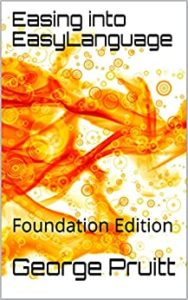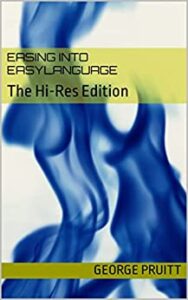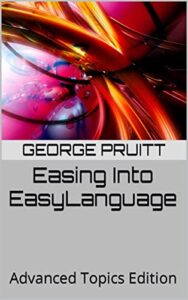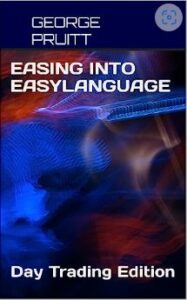The easiest way to program a multi step criteria entry/exit signal is to use a Finite State Machine (FSM). This is much easier than setting flags and then having to turn them on and off. Here is a diagram of a FSM:

All posts by George Pruitt
How to Round Up/Down To Nearest Tick in EasyLanguage
This is how you round to the nearest tick in EasyLanguage – helpful when plotting
price based indicators. Also the formula for calculating the min tick value is given.
vars: minTick(0),testPrice(0);
minTick = minMove/priceScale;
testPrice = close * .21 * range;
// round up
value1 = testPrice + (minTick-mod(testPrice,minTick));
// round dn
value2 = testPrice - (mod(testPrice,minTick));
{mod is a call to the modulus function
aka remainder function -- mod(12,5) = 2 -- 12/5 = 2 Remainder 2
say ES testPrice = 1123.57
minTick = .25
1123.57 + (0.25 - mod(1123.57,0.25)) = 1123.57 + 0.25 - 0.07 = 1123.75}
Correction to Thermostat and Bandit Description in Book
A very astute reader of the BWTSwTS2 has brought to my attention errors in my description of the Thermostat and Bollinger Bandit algorithms. In the Thermo description I incorrectly used the words yesterday and today. The code is correct in the book. Thanks to John for finding this!
Corrected description follows:
….If today’s closing price is greater than the average of today’s high,low and close, then we feel tomorrow’s action will probably be bearish. However, if today’s closing price is less than or equal to the average of today’s high, low, and close, then tomorrow’s market will behave in a bullish manner.
In addition John uncovered a typo as well for the Bollinger Bandit description – when I stated BELOW I meant ABOVE and vice versa.
Corrected description follows:
If liqPoint is BELOW the upband, we will liquidate a long position if today’s market action <= liqPoint.
If liqPoint is ABOVE the dnband, we will liquidate a long position if today’s market action >= liqPoint.
Correct King Keltner Easy Language
Several have brought it to my attention that the King Keltner code in the book is missing a couple of lines. Here’s the complete code in its entirety. Thanks for bringing this to my attention.
[LegacyColorValue = true];
{King Keltner Program
King Keltner by George Pruitt -- based on trading system presented by Chester Keltner
-- an example of a simple, robust and effective strategy}
Inputs: avgLength(40),atrLength(40);
Vars: upBand(0),dnBand(0),liquidPoint(0),movAvgVal(0);
movAvgVal = average((h+l+c)/3,avgLength);
upBand = movAvgVal + AvgTrueRange(atrLength);
dnBand = movAvgVal - AvgTrueRange(atrLength);
{Remember buy stops are above the market and sell stops are below the market
-- if the market gaps above the buy stop, then the order turns into a market order
vice versa for the sell stop}
if(movAvgVal > movAvgVal[1]) then Buy ("KKBuy") tomorrow at upBand stop;
if(movAvgVal < movAvgVal[1]) then SellShort("KKSell")tomorrow at dnBand stop;
liquidPoint = movAvgVal;
if(MarketPosition = 1) then Sell tomorrow at liquidPoint stop;
if(MarketPosition =-1) then BuyTocover tomorrow at liquidPoint stop;
Trade Input Version 2
I have requests from some users to program a little more sophisticated version of my trade input strategy. This is where you can simply list the trade, trade date, and trade price and TradeStation will plot the trades for you and calculate the performance. This is a an easier to use program then TS’s _HistoricalEntry strategy.
{If you are entering the next bar then use the prior bars date
Make sure your price is above or below open if stop or limit order
}
array: DateArray[1000](0),BorSArray[1000](""),PriceArray[1000](0);
vars: iCnt(1);
DateArray[1]=1141117; BorSArray[1]="S"; PriceArray[1]=75.00;
DateArray[2]=1141219; BorSArray[2]="F"; PriceArray[2]=59.01;
DateArray[3]=1150102; BorSArray[3]="B"; PriceArray[3]=53.10;
DateArray[4]=1150210; BorSArray[4]="S"; PriceArray[4]=50.00;
if date >= dateArray[1] then
begin
if date = dateArray[iCnt] then
begin
if BorSArray[iCnt] = "B" then buy next bar at PriceArray[iCnt] stop;
if BorSArray[iCnt] = "S" then sellShort next bar at PriceArray[iCnt] stop;
if BorSArray[iCnt] = "F" then
begin
if marketPosition = 1 then sell next bar at PriceArray[iCnt] stop;
if marketPosition =-1 then buytocover next bar at PriceArray[iCnt] stop;
end;
iCnt = iCnt + 1;
end;
end;
King Keltner from BWTSwTS Report
Like I stated in an earlier post the “Trend”, once a lost friend, is back. Check out the results from the King Keltner system as published in “Building Winning Trading Systems with TradeStation.” Looking at the results it looks like 2014 is as good as the “life saving” 2008. Is it time to re-think Trend Following – has the paradigm shifting pendulum swung back?
HYPOTHETICAL PERFORMANCE RESULTS HAVE MANY INHERENT LIMITATIONS, SOME OF WHICH ARE DESCRIBED BELOW. NO REPRESENTATION IS BEING MADE THAT ANY ACCOUNT WILL OR IS LIKELY TO ACHIEVE PROFITS OR LOSSES SIMILAR TO THOSE SHOWN. IN FACT, THERE ARE FREQUENTLY SHARP DIFFERENCES BETWEEN HYPOTHETICAL PERFORMANCE RESULTS AND THE ACTUAL RESULTS SUBSEQUENTLY ACHIEVED BY ANY PARTICULAR TRADING PROGRAM.
ONE OF THE LIMITATIONS OF HYPOTHETICAL PERFORMANCE RESULTS IS THAT THEY ARE GENERALLY PREPARED WITH THE BENEFIT OF HINDSIGHT. IN ADDITION, HYPOTHETICAL TRADING DOES NOT INVOLVE FINANCIAL RISK, AND NO HYPOTHETICAL TRADING RECORD CAN COMPLETELY ACCOUNT FOR THE IMPACT OF FINANCIAL RISK IN ACTUAL TRADING. FOR EXAMPLE, THE ABILITY TO WITHSTAND LOSSES OR TO ADHERE TO A PARTICULAR TRADING PROGRAM IN SPITE OF TRADING LOSSES ARE MATERIAL POINTS WHICH CAN ALSO ADVERSELY AFFECT ACTUAL TRADING RESULTS. THERE ARE NUMEROUS OTHER FACTORS RELATED TO THE MARKETS IN GENERAL OR TO THE IMPLEMENTATION OF ANY SPECIFIC TRADING PROGRAM WHICH CANNOT BE FULLY ACCOUNTED FOR IN THE PREPARATION OF HYPOTHETICAL PERFORMANCE RESULTS AND ALL OF WHICH CAN ADVERSELY AFFECT ACTUAL TRADING RESULTS.
Importing Trades into TradeStation
I have often developed programs that use data that TradeStation may not have in their database, and later wanted to use the signals generated on that data and it apply it to another market. Here is a simple program that uses arrays to specify trade dates and signals. The code to interpret the arrays and then execute the orders follows:
array: DateArray[1000](0),BorSArray[1000]("");
vars: iCnt(1);
DateArray[1]=1081228; BorSArray[1]="S";
DateArray[2]=1081229; BorSArray[2]="B";
DateArray[3]=1090104; BorSArray[3]="S";
if date >= dateArray[1] then
begin
if date = dateArray[iCnt] then
begin
if BorSArray[iCnt] = "B" then buy this bar on close;
if BorSArray[iCnt] = "S" then sellShort this bar on close;
iCnt = iCnt + 1;
end;
end;
Notice how arrays are defined and declared. How do you think you would handle a system that goes flat?
The Trend is Still Your Friend!
TF is the easiest trading you will every do. Is it perfect – no! Crude, currencies, financials, indices all big winners this year. 2014 may not be 2008 but it is shaping up very nicely. I will post some TF results next week!
Building Winning Trading Systems with TS – System Update
These are hypothetical numbers and there are no guarantee historical performance will be repeated in the future. Here is an update to the performance of the Russell Day trade system described in the book. Looking Good!
HYPOTHETICAL PERFORMANCE RESULTS HAVE MANY INHERENT LIMITATIONS, SOME OF WHICH ARE DESCRIBED BELOW. NO REPRESENTATION IS BEING MADE THAT ANY ACCOUNT WILL OR IS LIKELY TO ACHIEVE PROFITS OR LOSSES SIMILAR TO THOSE SHOWN. IN FACT, THERE ARE FREQUENTLY SHARP DIFFERENCES BETWEEN HYPOTHETICAL PERFORMANCE RESULTS AND THE ACTUAL RESULTS SUBSEQUENTLY ACHIEVED BY ANY PARTICULAR TRADING PROGRAM.
ONE OF THE LIMITATIONS OF HYPOTHETICAL PERFORMANCE RESULTS IS THAT THEY ARE GENERALLY PREPARED WITH THE BENEFIT OF HINDSIGHT. IN ADDITION, HYPOTHETICAL TRADING DOES NOT INVOLVE FINANCIAL RISK, AND NO HYPOTHETICAL TRADING RECORD CAN COMPLETELY ACCOUNT FOR THE IMPACT OF FINANCIAL RISK IN ACTUAL TRADING. FOR EXAMPLE, THE ABILITY TO WITHSTAND LOSSES OR TO ADHERE TO A PARTICULAR TRADING PROGRAM IN SPITE OF TRADING LOSSES ARE MATERIAL POINTS WHICH CAN ALSO ADVERSELY AFFECT ACTUAL TRADING RESULTS. THERE ARE NUMEROUS OTHER FACTORS RELATED TO THE MARKETS IN GENERAL OR TO THE IMPLEMENTATION OF ANY SPECIFIC TRADING PROGRAM WHICH CANNOT BE FULLY ACCOUNTED FOR IN THE PREPARATION OF HYPOTHETICAL PERFORMANCE RESULTS AND ALL OF WHICH CAN ADVERSELY AFFECT ACTUAL TRADING RESULTS.
Using Strings in EL for multi-step System
This little strategy uses EasyLanguage’s string manipulation to keep track of a multi-step, mutli-criteria, multi-state trade entry. You don’t buy until the buyString is equal to “BUY”. The sell side is just the opposite. When you program a multi-step entry you also need to build a reset situation. In the case of this system you reset the string to null(“”) when the price dips back down below the 9 day moving average. After resetting the process starts over again.
{Use curly brackets for mult-line
comments
This system needs three criteria to be met
before a trade is initiated
Buy Criteria 1: C > 9 day movAvg - trend Up
Buy Criteria 2: H = HighestHigh 10 days - break Out
Buy Criteria 3: C < C[2] - retracement }
vars:buyString(""),sellString("");
if marketPosition = 0 then {If flat then reset strings}
begin
buyString = "";
sellString = "";
end;
if c >= average(c,9) then buyString = "B"; //First criteria met
if c < average(c,9) then buyString = "";
if c > average(c,9) then sellString = "";
if c <= average(c,9) then sellString = "S";
if buyString = "B" then
begin
if h > highest(h,10)[1] then buyString = buyString + "U"; //Second Criteria met
end;
if buyString = "BU" then
begin
if c < c[2] then buyString = buyString + "Y"; //Third criteria met
end;
if buyString = "BUY" then buy ("BuyString") next bar at open; //Read BUY
if sellString = "S" then
begin
if l > lowest(l,10)[1] then sellString = sellString + "E";
end;
if sellString = "SE" then
begin
if c > c[2] then sellString = sellString + "LL";
end;
if sellSTring = "SELL" then sellShort ("sellString") next bar at open;
setStopLoss(1000);
SetPercentTrailing(1000, 30); 




